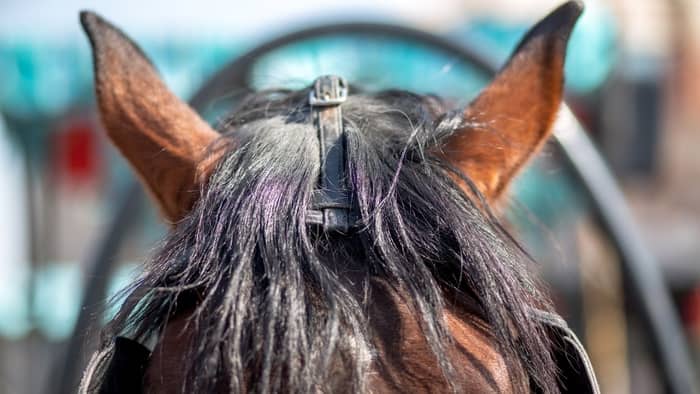Last Updated on February 27, 2022 by Griselda M.
Ear mites in horses are a relatively rare but problematic condition that can be difficult to treat. If your horse is showing signs of itching around his ears or shaking his head, he might be suffering from ear mites. Let’s find out everything you need to know about this condition!
What Are Ear Mites In Horses?
Many species of animals can suffer from mites, and horses are no exception. Mites are tiny creatures that live on the surface of the skin; some types of mites will also burrow into the surface of the skin. Each type of mite is highly specialized to live on certain species of animals and will colonize different areas.
There are two types of mites that can live in the ears of horses:
-
Psoroptic Mites
These are non-borrowing mites that live on the surface of the skin in the ear canal of horses. Some horses can have these mites with no outward sign of infection. Others will rub their ears and shake their heads, in response to the itching caused by the mites.
-
Sarcoptes Scabiei
This type of mite is commonly found in dogs and pigs, but can also infect horses. Also known as Sarcoptic mange, these mites are very itchy and can spread quickly. They are also much more transmissible between horses and can survive for some time in the environment.
How Are Ear Mites In Horses Diagnosed?
If you suspect that your horse has ear mites, your veterinarian will observe the clinical signs and potentially carry out some tests to confirm the diagnosis.
Psoroptic mites cause small, scabby bumps on the surface of the skin, as well as hair loss and dry, scaly skin. The clinical signs of sarcoptes scabiei are similar, but the horse will be much more itchy and the skin will become thickened and leathery.
To confirm the diagnosis, your veterinarian will take a sample of the cells and debris on the surface of the inner ear. This is not painful for the horse but most horses do not like having their ears handled, so your veterinarian will most likely advise that it is necessary to sedate the horse. A skin scraping can then be taken and examined under a microscope to identify mites.
If ear mites are diagnosed, you will need to medicate your horse’s ears to eliminate the problem. This may be a one-off treatment, although repeated medication may required in the case of a severe infestation.
What Other Ear Problems Do Horses Get?
Luckily, horses do not often get problems with their ears! This is one area of the horse that can be very difficult to treat, and most horses resent having medication applied to their ears. Ear mites in horses are very rare, so what other conditions might cause ear problems in horses?
-
Ticks
Ticks are an insect that attaches to the skin, sucking the blood from the horse. They can be found on the external surface of the horse’s ear, as well as inside the ear canal.
-
Flies
Biting flies can cause problems in horse’s ears, particularly in warmer climates. Biting flies in horses include sable flies, black flies, and biting midges.
-
Aural Plaques
Aural plaques are found on the inner surface of the horse’s ear. They are raised, pink bumps, caused by a papillomavirius transmitted by black flies.
-
Frostbite
In exceptionally cold climates, the tips of the horse’s ears can suffer from frostbite. This is where the cells of the ear get so cold that the tissue dies.
How To Look After Your Horses Ears?
Horses ears are naturally self-cleaning, and they do not require routine cleaning and maintenance. The hairs inside and outside the ear do a great job of keeping debris at bay.
However, there is no harm in giving your horse’s ear a gentle clean once in a while. It is important to remember that you should not put anything inside the ear, but you can wipe around the edges of the ear with damp cotton wool to remove dirt.
Some people like to trim the hair inside a horse’s ear to make it look tidier, but this can impair the ear’s ability to keep itself clean. It is better to keep any trimming to a minimum, allowing the ear hair to perform its normal natural function.
Summary
So, as we have learned, ear mite infections are very rare in horses, and there are many other conditions that cause similar symptoms. Your veterinarian may take a sample of skin, called a skin scrape, from the inside of the ear to diagnose ear mites.
We’d love to hear your thoughts on ear mites in horses! Have you ever had to give treatment to a horse that has ear mites? Or maybe you’ve got a question about how to diagnose ear mites in horses? Leave a comment below and we’ll get back to you!
FAQs
Why Do Horses Get Ear Mites?
Like most insect infestation, ear mites can be passed from one horse to another. If your horse has ear mites, your veterinarian might suggest that all the horses in the barn or field are treated, whether they show symptoms or not.
What Are The Symptoms Of Ear Mites In Horses?
Some horses with ear mites show no symptoms at all. Others will shake their head and rub at the ears. It is not uncommon to see a horse with a drooping ear if it is infested with ear mites.
Depending on the type of ear mite, the skin may become inflamed and bumpy. Closer inspection will reveal small scabs on the surface of the ear. Horses with ear mites can be very sensitive about having their ears touched.
What To Use For Ear Mites In Horses?
Your veterinarian will advise you on the best treatment for ear mites for horses. One option is a mixture of pyrethrin and ivermectin, applied directly to the ear
How To Treat Ear Mites In Horses?
Your horse may not be happy about having ear mite treatment applied. In this case, you may need to ask your veterinarian to supply you with a sedative. This will help you to make sure that the ear mite treatment is applied correctly.


